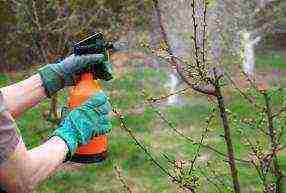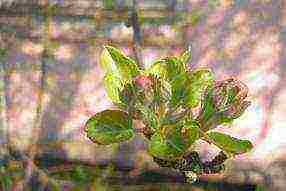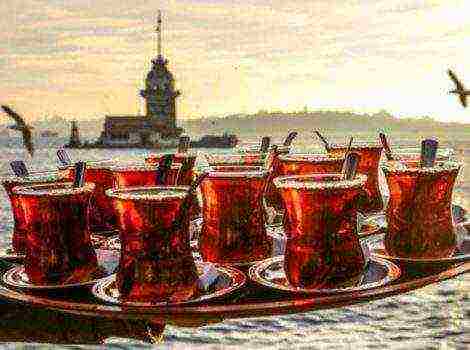Content
- 1 Rating of the best varieties of apple trees
- 2 The best summer varieties of apple trees
- 3 The best autumn varieties of apple trees
- 4 The best winter varieties of apple trees
- 5 How to choose an apple tree for your garden?
- 6 4 best early varieties of apple trees for the Urals and Siberia
Review of the best varieties of apple trees - according to gardeners' reviews
The apple tree occupies a leading place in Russian orchards. It is ideal for our soil and climatic zone and is ubiquitous. On the territory of Russia, 324 varieties have been zoned, not counting new varieties under testing. We present to you a description of the best varieties of apple trees - according to reviews of experienced gardeners.
When laying an apple orchard, they are guided by the following advice: 1 tree of summer ripening, 1 - 2 trees of autumn varieties and 2 - 3 trees of winter varieties for storage. If the area of the site allows, then the number is increased, maintaining the proportion. Summer apples are consumed fresh directly from the branch, so a large harvest risks simply rotting. Autumn varieties are not stored for long, but they go well for processing. It is advisable to plant many trees of winter varieties if there is space for storage.
Rating of the best varieties of apple trees
The best summer varieties of apple trees
|
Melba 300 (one year old with open root system) Our rating of the best apple varieties Melba opens - a zoned variety of Canadian selection with a 120-year history, ripens in mid-August. Trees with medium vigor, with a spherical crown. Fruits are laid mainly on ringlets, but mixed fruiting is characteristic. Apples weighing 150 - 170 g, round-elongated, with slight ribbing. The skin is smooth and thin, with a waxy coating. The color of ripe fruits is milky green with a striped deep red blush covering half of the apple. The pulp is white, juicy, tender, sweet with sourness, there is a candy aroma. They perfectly tolerate transportation; when cooled, healthy, slightly unripe apples are stored for 50 - 60 days. The productivity of an adult tree is 85 - 150 kg. In severe winters, frost cracks and freezing of growth are noted. In some years, it suffers greatly from scab, therefore, in areas with frequent epiphytoties, preventive treatments are used. It is successfully grown in the Middle lane. Main pluses:
Minuses:
|
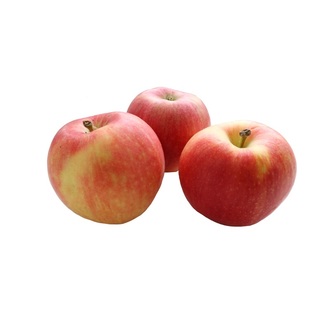 9.9 / 10 Rating Reviews The best variety of apple trees for the Moscow region and the middle lane. The taste of apples is wonderful, juicy and sweet. But at me it often freezes.
|
|
Orlovim 780 (for a three-year seedling with ZKS, on a clonal rootstock) Russian variety of a new generation, ripening in mid-August. Apples ripen gradually, extending the consumption period until the end of September. Trees grow quickly, forming a spherical crown of medium density. The apples are conical, slightly beveled, with slight ribbing, weighing on average 120 - 170 g. The skin is glossy. The color is greenish-yellow with a blurred blush and bright red stripes over the entire surface.The pulp is creamy, dense, very juicy, aromatic, sweet and sour. Up to 100 kg of apples are harvested from an adult tree. Differs in increased winter hardiness, fruits and leaves are not damaged by scab. In the State Register for the Central Region, it is successfully grown throughout the Middle Lane. Main pluses:
Minuses:
|
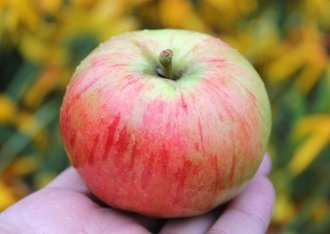 9.8 / 10 Rating Reviews Refers to late summer apple trees. After removal, it can be stored in the refrigerator for another month without losing its taste.
|
|
Mantet 450 (for a one-year seedling in a container) An old Canadian variety included in the State Register. The fruits ripen by the end of July, but in unfavorable years, the dates are shifted to mid-August. The tree is of medium height, with a sparse crown extended upwards. The fruits are formed on the ringlets. In terms of size, the fruits are at the level of the average, weigh from 90 to 180 g, the shape is close to conical, with a slight ribbing at the top. The color of ripe apples is yellowish with a dotted-striped blush on an orange-red background. The skin is thin and smooth. The pulp is white, tender, juicy-sweet with a slight sourness. Apples are not highly marketable, they are intended for amateur cultivation. When the crop is overloaded, the fruits become very shallow. Ripe apples are consumed immediately or within 10 days. The variety is characterized by uncomfortable ripening, which is an advantage as the apples can be gradually torn off for fresh consumption. In a rainy summer, scab develops on the leaves. Recommended for the Middle Volga and Central regions. Main pluses:
Minuses:
|
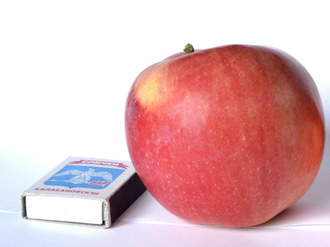 9.8 / 10 Rating Reviews A very good variety of apples, but gentle in frost resistance.
|
|
August 550 (for a two-year seedling on a clonal rootstock, ZKS) A new Russian variety of apple trees is being tested, ripening occurs in the 2nd - 3rd decade of August, the consumer period lasts until mid-September. Tall trees with a spherical crown. Apples are large, weighing 160 g and above, slightly elongated, beveled, with wide ribbing. The skin is glossy, yellow-green when ripe with a blurred red blush over most of the surface. The pulp is greenish, coarse-grained, juicy, refreshing sweet and sour taste. In the years of mass distribution of scab on trees, a weak degree of damage to leaves and fruits is noted. Frost resistance is assessed as above average. The productivity of young trees is at the level of 25 kg, and of adults - 100 - 120 kg. The best results are obtained when grown in the Central Black Earth region. Good reviews from gardeners from the Moscow region and the Volga region. Main pluses:
Minuses:
|
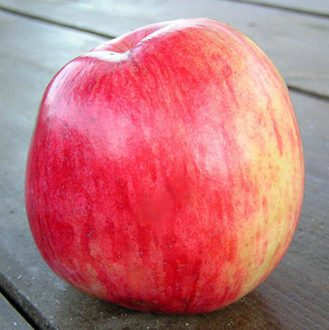 9.7 / 10 Rating Reviews A good apple tree for the Moscow region, ripens a little later than Melba, and takes first place in my collection for taste. The apples are large, marketable, but without a bright aroma.
|
The best autumn varieties of apple trees
|
Darling 550 (two-year seedling on a clonal rootstock, ZKS) The rating of the best varieties of apple trees Chosen one continues - a variety of Russian selection with ripening in late August - early September. The tree is weak, with a compact sparse crown. The apples are above medium in size, round, with slight ribbing. The color is yellow with a bright red streaky cover. The pulp is creamy, fine-grained, tender, juicy-sweet with a pleasant sourness. The fruits are stored until November. After removal, they are ready for use, do not require ripening. Recommended for the Lower Volga and Northwest regions. Main pluses:
Minuses:
|
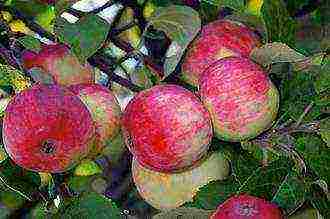 9.7 / 10 Rating Reviews My favorite autumn apple variety. The tree is semi-dwarf (less than 3 meters), the apples are one-dimensional and very large, of excellent taste.
|
|
Uspenskoe 550 (two-year seedling on a clonal rootstock, ZKS) Nice new variety of apple trees from Michurinsk. A tree of medium height, with a spreading crown. Mixed type of fruiting. The apples are large, round-oval, with smooth skin. The color of ripe fruits is greenish-yellow with a red blurred blush. The pulp is white, tender, juicy, fine-grained, sweet and sour. Apples have a table purpose. After removal, they are stored for 2 - 3 months. The most favorable growing areas: Voronezh, Lipetsk, Tambov, Oryol, Kursk and Belgorod regions. Main pluses:
Minuses:
|
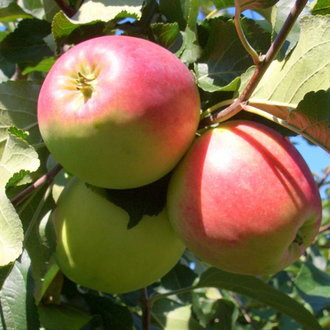 9.7 / 10 Rating Reviews This apple tree has good annual fruiting. Freezing of growth and buds during cultivation was not observed.
|
|
Zhigulevskoe 550 (for a two-year seedling on a clonal rootstock, ZKS) A proven variety of apple trees of the Samara selection with late autumn ripening. The tree is large, with a wide-pyramidal, non-thickened crown. Fruiting on ringlets and twigs. The apples are large, weighing from 120 - 200 to 350 g, round, with a slight tuberosity. The skin is firm, shiny, with an oily cover. The color is yellowish with an intense red striped blush spreading over the entire surface. The pulp is creamy, tender, coarse-grained, sweet with pleasant sourness. Ready for use 2 - 3 weeks after removal. The consumer period lasts 2.5 - 3 months (September to December - January). Shows average winter hardiness; in years with severe winters, frost cracks appear. The scab is not affected, it suffers greatly from the moth. Recommended for the Central, Central Black Earth regions, the Volga region and the North Caucasus. Main pluses:
Minuses:
|
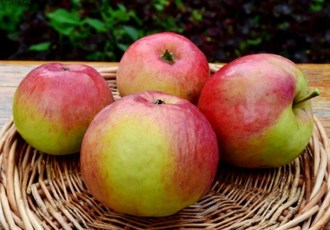 9.7 / 10 Rating Reviews I remove the apples slightly unripe, if overexposed on a branch - they are poorly stored. Apples are highly marketable and tasty.
|
The best winter varieties of apple trees
|
Imant 400 (two-year seedling with ZKS, on seed stock) A promising variety of Belarusian apple trees with a late winter period of consumption. The tree is medium-sized, with a compact, rounded, sparse crown. The chain type of fruiting prevails on 70%. The apples are large, weighing 180-200 g, round-conical, wide-ribbed, of various sizes. The skin is dense, of medium thickness, with a waxy coating. The color is green with a purple cover of a violet hue. The pulp is creamy with a greenish tinge, dense, prickly, very juicy, fine-grained, harmonious sweet and sour taste. Fruits are stored for 7 - 8 months. Winter hardiness in different regions is assessed as high or medium. When the growth freezes, the tree quickly recovers and bears fruit well this year. This variety of apple trees is successfully grown in the Moscow region and many areas of the Central strip. Main pluses:
Minuses:
|
 9.8 / 10 Rating Reviews For me, the variety is in first place for taste among winter ones, only unattractive color confuses.
|
|
Lobo 780 (three-year seedling with ZKS, on a clonal rootstock) An early winter variety of Canadian apple trees. The young crown is vertical, but with age it becomes wide-rounded and rather sparse. Mixed type of fruiting. The tree lends itself well to shaping, it is recommended for growing a "slender spindle" on a dwarf rootstock. Apples are large 150 - 250 g, round-conical or flattened, slightly ribbed.The skin is smooth, with a strong waxy bloom of a bluish color. The color is yellowish-green with a blurred, striped, crimson blush; when removed, the surface acquires a burgundy hue. The pulp is snow-white, tender, fine-grained, juicy-sweet. The fruits are stored until March. Zoned in the Central Black Earth zone, actively grown throughout the Middle zone. In the conditions of the Lower Volga region, it manifests itself as an autumn variety with a short storage period. In the Moscow region, it is distinguished by average winter hardiness. Main pluses:
Minuses:
|
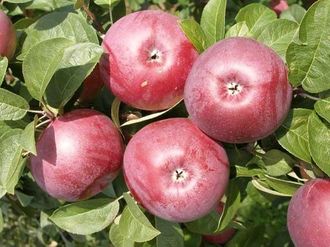 9.8 / 10 Rating Reviews I leave the apples on the tree until the first days of October. They do not crumble and gain significant weight. A quarter of a crop weighing 300 g or more.
|
|
Bryansk 550 (two-year seedling on a clonal rootstock, ZKS) It is included in the State Register as an early winter variety, but gardeners attribute it to a late autumn variety due to a short storage period. The tree is of medium height and quickly reaches normal size. Forms a spherical crown with an average degree of thickening. Mixed fruiting. The apples are large, weighing from 150 to 300 - 400 g, round, with a slight ribbing. The skin is thin, glossy. The color is greenish with a dark crimson cover over the entire surface. The pulp is white, juicy, sweet with a slight sourness and strong aroma. Grafting into the crown of an adult tree bears fruit for 2 years. Fruits are not affected by scab, but are susceptible to fruit rot. Apples are intended for fresh consumption in the autumn or for short storage (until December - January) in the refrigerator. By the end of storage, the pulp of the fruit becomes friable, taste decreases. The declared characteristics of the variety are maximally revealed in the Central Region. Good adaptive properties expand the distribution area in the Middle Belt. Main pluses:
Minuses:
|
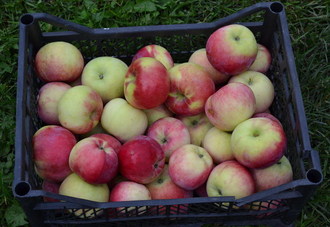 9.7 / 10 Rating Reviews Apples are highly marketable, intensely colored. The tree is prone to being overloaded by the harvest: branches even break under a large number of large apples.
|
The apple tree is a tall tree that requires a lot of space to develop. To restrain growth, use competent shaping and undersized rootstocks. For amateur gardens, seedlings are grown on vigorous and semi-dwarf rootstocks (54-118 and MM106). For industrial plantings with intensive technology, clonal dwarf rootstocks are used. When you have a small plot at your disposal, you can expand the assortment of apple trees by grafting into the crown instead of planting individual seedlings. On summer cottage forums, it is easy to find a gardener who will bring both the stalk and the vaccine. This service is paid, but it does not cost more than a seedling. Another way out is to learn how to graft yourself (cuttings are often given away for free). Have a nice harvest!
Attention! The reliability of the information and the results of the ratings is subjective and does not constitute advertising.
A favorite fruit tree wherever the climate is suitable for growing it is the apple tree. Early, middle, late, sweet, sour, with a spreading crown and columnar, apple trees rank first among fruit crops.
Apples on the branches of a tree
Moderate watering and climate are sufficient for apple trees, without a lot of bright sunny days. They are unpretentious in care. In cultivated form, fruiting begins in the 4th - 10th year and yields are formed up to 40-50 years of age. Apples are loved by every family and are needed for a long period. How to select the best of the best, what features to pay attention to when choosing varieties?
How to choose an apple tree for your garden?
In order to select an apple tree for your garden that is suitable in all respects, you need to study the varieties bred for the region / district and pay attention to the following characteristic features.
Winter hardiness of the variety
The ability to withstand the most severe frosts, typical for the area, and successfully withstand spring return frosts, autumn sudden drop in temperature and other weather disasters. The winter hardiness of the variety in apple trees is not brought up. Cold resistance is passed on from parents at the genetic level. Therefore, regardless of the region, you always need to buy zoned apple varieties for planting. They are bred for certain climatic conditions, are less affected by pests and less infected with diseases.
The onset of fruiting and yield
For the home, it is better to buy early varieties of apple trees that form the first harvest in the 2nd - 4th year. Medium-fruited crops form in the 5th - 8th year and late-fruited ones - in the 9th - 10th - 12th year.
Productivity. It is advisable to select varieties of apple trees with annual fruiting.
Ripening period of apples
For a personal plot, it is necessary to select varieties with early, middle and late ripening so that summer varieties are replaced by autumn ones, and those by winter ones.
Summer varieties of apple trees are harvested in late July and early August, depending on the region. They reach biological ripeness for mass consumption of fruits, but they must be immediately used for food.
Mid-season apples are harvested in technical ripeness in September. When choosing varieties, it is necessary to pay attention to the fact that some autumn varieties need to ripen after harvest in order to acquire their characteristic taste and aroma.
Late apples are usually harvested in late September - early October. In addition to late and mid-late, there are late-ripening varieties that are harvested at the end of October or before the onset of frost. Such varieties are immediately laid for storage. Their fruits reach their maximum ripeness gradually.
Apple tree of autumn variety
Keeping apples
From varieties of apple trees of different ripening periods, varieties with good keeping quality should be selected according to the variety catalog. At the same time, pay attention to the fact that summer varieties have a shelf life of 1-3 weeks, but some lose quality indicators after 6 days (darken, rot, etc.). In autumn varieties, good keeping quality is considered to be 30-60 days, and in winter varieties at least 3-4 months. The best winter varieties of apples can be stored (if appropriate conditions are created), retaining all qualities, until the end of March - May and even until the next harvest.
Disease resistance of apple trees
You should choose a variety of apple trees with high resistance to diseases, especially to fungal (scab, rot and others) and pests. For "high-immune" varieties, fewer treatments will be required, which will reduce the time and care costs in the future and will allow you to get harvests of ecologically healthy fruits.
Crown shape
For a private garden with a small area, it is more practical to choose a variety of apple trees with a small or medium, compact crown habit. Particularly advantageous in this case are columnar varieties that form a crop on the central trunk and do not have a crown in the conventional sense. A spreading, loose crown will be good in a resting corner, where it creates the necessary shade for vacationers, but in the garden it will occupy a large area and oppress other cultures.
Taste is not in the last place
When choosing a variety of apple trees, be sure to pay attention to the quality indicators of the fruits: sweet, sour, juicy, with dense or loose pulp. Sweet varieties contain sugars from 10% or more.
For example: Start and Bolotovskoe 10.5%, Kandil Orlovsky 10.3%, and Rozhdestvenskoe 11.1%. The fruits of these varieties contain up to 0.4% free acid.
Pay attention in the characteristics of varieties to such an indicator as the sugar-acid coefficient. With an indicator of 25% and above, apples are sweet (acidity is not felt in the aftertaste).At lower rates (10-20%) - the taste of the fruit is sour, like lemon. From 20 to 25% the taste is felt as sweet and sour, sweet and sour with a different aftertaste.
Here are the ten best apple varieties for the middle lane.
For a list of the best apple varieties for the middle lane, see the next page.
The State Register includes about 400 varieties of apple trees. And if you add local, new or outdated, but still living in our gardens, then the list will turn out to be impressive. What are the most common varieties?
Each region has its own favorites. We have compiled a kind of top-5 of the most popular varieties for central Russia with different ripening periods. We also offer an alternative - less common, but noteworthy varieties.
We advise you to remember them when the time comes to replace the old apple tree. A very good way to replenish the assortment of your garden is to plant new varieties in the crown of already proven old-timers.
Number 1. Pouring white - an old local early summer variety, the very first apple of the season, ripens from the beginning of July.
Dessert tender friable sweet-sour pulp is to many to taste, fruits weighing 80-110 g. The variety is distinguished by high winter hardiness. Fruiting periodically sharply. Years with a bountiful harvest usually bring problems - apples are stored for no more than two weeks, their transportability is weak. Scab attacks trees, especially in wet years.
Number 2. Melba is an unsurpassed Canadian variety in popularity.
It belongs rather to late summer or even early autumn, the fruits ripen in mid-September. He earned national love with his sweet and sour taste, his snow-white juicy pulp has a strong pleasant aroma. Fruits are medium (weight - 80-120 g). Apples are stored for 1-2 months. The tree is winter-hardy, fruitful, with high self-fertility. The disadvantages of the variety include the frequency of fruiting and the susceptibility to scab. The fruits do not ripen at the same time and quickly crumble.
Summer varieties - an alternative
Arkadik is an early summer domestic variety (VSTISP, Moscow), capable of competing with southern summer varieties. Juicy, sweet with barely noticeable sourness, the pulp has a strong aroma.
Fruits are medium and large (weight - from 80 to 180 g). The tree is vigorous, fast-growing, winter-hardy. Grows reliably in the Moscow region and northern regions of central Russia. The variety is scab resistant.
Mantet is a late summer variety of Canadian origin.
Creamy (pink under the skin) tender juicy pulp with a sour-sweet taste and strong aroma. The fruits are of medium size (about 130 g), they do not ripen at the same time, their consumption period is about a month. The apple tree is winter-hardy, fruitful, fast-growing, scab resistant. The disadvantages include susceptibility to powdery mildew, poor transportability of fruits (stored after removal for no more than 15 days) and the frequency of fruiting.
In memory of Tikhomirov - a late summer fruitful variety (Lomonosov Moscow State University), ripens in the second half of August.
Fruits are large (weight - 100-150 g), sweet and sour. The pulp is juicy, creamy, of medium density, prickly, fine-grained. The apple tree is medium-sized, begins to bear fruit in the 6th year. The variety is self-fertile, scab resistant, winter-hardy.
Number 3. Autumn striped, also known as Streyfling, or even Shtrifel, is a popular autumn Baltic variety of folk selection.
Dense, tender, juicy, slightly yellowish pulp of these apples has a pleasant light wine flavor. Fruits are above average in size (weight - 120 g), ripen at the end of August, have good transportability, can be stored until mid-November. The plant is winter-hardy, productive, scab resistant. Gardeners should take into account that the tree of this variety is vigorous, begins to bear fruit in the 7-9th year.
Autumn varieties - an alternative
Zhigulevskoe is a late autumn variety created at the Kuibyshev Experimental Gardening Station.
Apples ripen in mid-September and can be stored until February. Large fruits (weight - 150-200 g) with creamy dense juicy sweet-sour pulp with a pleasant aroma. The tree is winter-hardy, medium-sized, fruitful. The variety is self-fertile (the best pollinators are Antonovka ordinary, Cinnamon new), weakly resistant to scab, prone to periodic fruiting.
Orlovskoe striped - an autumn variety (All-Union Research Institute for Breeding of Fruit Crops, Orel), ripening in early September.
The fruits are stored until early December. The pulp is white with a creamy shade, fine-grained, tender, very juicy and aromatic. The taste is sweet and sour. Fruits are large or above average size (weight - 130 g). The trees are fruitful, fast-growing, with regular fruiting. The variety is relatively resistant to scab, average winter hardiness (for the conditions of the Oryol region - above average).
Number 4. Antonovka ordinary is an old local Central Russian variety of late autumn or early winter period of consumption (in the State Register it is listed as early winter).
The fruits ripen in mid-September and are stored for up to 2-3 months. The pulp is juicy, coarse-grained, white, with some excess of acid (and a high content of vitamin C) and a unique aroma. The fruits are large (weight - 125-170 g). The tree is winter-hardy, vigorous, fruitful. The disadvantages include sharply periodic fruiting, poor transportability of fruits, susceptibility to scab and moth.
Number 5. Bogatyr is a winter variety created in Michurinsk.
Fruits ripen in late September - early October, can be stored until May, and have good transportability. The pulp is firm, slightly juicy, crispy, white, with a sweet and sour taste and a pleasant aroma. The fruits are large (average weight - 175 g, maximum - up to 350 g). The tree is fruitful, tall, has an average winter hardiness and resistance to scab.
Winter varieties - an alternative
Orlik is a winter variety (All-Russian Research Institute of Breeding of Fruit Crops, Orel).
The fruits are harvested in the first half of September, at which point they are ready for consumption and can be stored until March. The dense, fine-grained, very juicy pulp has a strong aroma and a harmonious sweet and sour taste. Medium-sized fruits (90-100 g). The trees are quite winter-hardy, medium-sized. The variety is fast-growing, fruitful, moderately resistant to scab, differs in the frequency of fruiting.
Sinap Orlovsky is a late winter variety (All-Russian Research Institute for Breeding of Fruit Crops, Oryol).
The fruits are harvested at the end of September, but consumer ripeness begins in November and lasts until the end of April. The pulp is greenish-creamy, very juicy, prickly, has a good taste, a harmonious combination of acid and sugar, and a weak aroma. Fruits are medium and large in size (weight - 120-150 g). The trees are quite winter-hardy, vigorous, regular, moderate fruiting. The variety is relatively scab resistant.
The subtleties of cleaning and storage
Growing an apple crop is not easy, but it can be more difficult to preserve it. Fruits for long-term storage are harvested in dry weather, only by hand and with great care. It is unacceptable to shake apples from trees, broken fruits are not stored. They are harvested along with the stalk. Do not remove apples by pulling them down, twisting or pulling. This leads to the breaking off or pulling of the stalks and the breakage of the fruit twigs.
Most apple varieties are best stored at temperatures close to zero and 90-95% humidity. At lower humidity, the fruits begin to wilt (the skin becomes wrinkled). Sharp temperature fluctuations at high air humidity lead to the appearance of moisture on the surface of the fruit, which leads to their massive rotting.
Enemy forces
Gardeners aren't the only ones who love to eat apples. One of the main enemies of the summer resident - apple moth. The main protection measures are cleaning, collection and destruction of dead bark in autumn or early spring, the use of trapping belts, constant collection and processing of volunteers during the summer. Amateur gardeners often use fermenting apple juice, which, in addition to the moth, also attracts moths, scoops and other insects.
Apple blossom beetle deprives many summer residents not only of the harvest, but even of the joy of admiring the spring flowering of trees. You need to start protecting the garden from the apple blossom beetle in early spring - trapping glue belts are applied to the stem. Beetles are shaken off the branches during the period of bud swelling before the inflorescences protrude. The procedure should be carried out early in the morning at air temperature.
not higher than 8–10 ° С, then the beetles are inactive. This successfully replaces the chemical treatment against the apple blossom beetle.
The most harmful disease of the apple tree is considered scabwhich lowers the yield and weakens the tree in general. When laying a garden, it is worth choosing modern, disease-resistant varieties. The main preventive measure is cleaning the affected leaves after they have fallen from the garden; they can be burned, buried, composted. Treatment of the soil surface after leaf fall and tree crowns with concentrated solutions of mineral fertilizers with a high nitrogen content (7% urea solution or 10% ammonium nitrate solution) significantly accelerates leaf mineralization, and the dormant stage of the pathogen does not have time to form. But in years favorable for the development of scab, and on varieties susceptible to disease, it is impossible to cope with the disease without the use of fungicides.
When choosing the best varieties of apple trees for planting on your own plot, you should focus on many factors - the climate of the region, the quality and fertility of the soil, taste preferences, susceptibility to diseases, etc. Considering that there are 83 regions in Russia, most of them differ from each other in terms of climate radically. What grows easily in Krasnodar and Crimea will not even give color in the Urals, and vice versa. In our article you will find out which are the best varieties of apple trees for the Moscow region, and which are ideal for central Russia.

4 best early varieties of apple trees for the Urals and Siberia
Early ripening in these regions occurs in mid-summer - the second decade of July, while the harvest is stored very little, no more than 2 months.
White filling
The tree yields a harvest already 4 years after planting the seedling. The apples are tasty, aromatic, easily removed from the stalk, but when overripe they fall and break. Stored for no more than 3 months, suitable for canning.
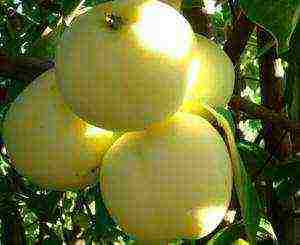
White filling
Melba
The harvest also occurs in the 4th year after planting. The fruits are very sweet, large - on average they reach 150-180 grams, the shelf life is short - within 3 months, but during maturation the apples do not turn black and do not become soft.
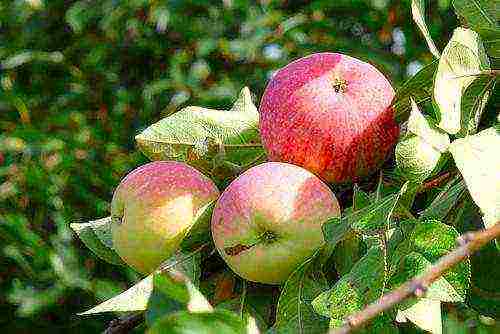
Melba
Ligol
If you choose which varieties of apple trees are best planted in the Moscow region, then it is Ligol that you need to pay attention to. This is a hybrid variety that yields very large - 270-300 grams - fruits that can be stored for up to 6 months. The tree is unpretentious in care, reacts well to soil fertility, bears fruit every year.
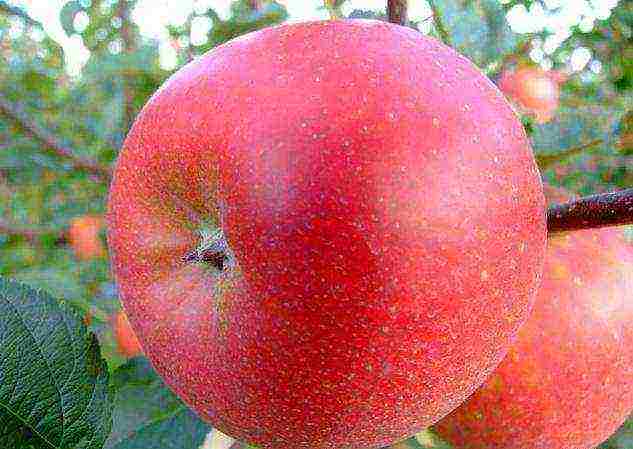
Ligol
Antonovka
This variety is difficult to classify as early, although it does not ripen as late as others. Antonovka gives the first harvest 6-7 years after planting, reacts sensitively to the quality of the soil, loves watering - it is recommended to water at least 2-3 times per season. The presence of weeds surrounding the tree can reduce the yield. The fruits are large (500 gr.), Fragrant, juicy, perfect for preservation and juices. They are stored a little - up to 3 months.
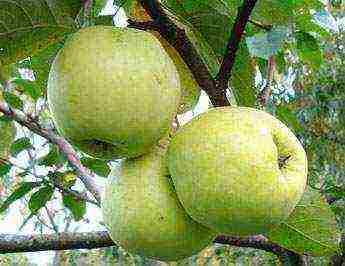
Antonovka
Read with this article: Continuous herbicides - effective formulations
4 best varieties of middle and late ripening apple trees for the Urals and Siberia
As for all other regions, the best apple varieties for central Russia, which yield crops in the second half of autumn, are distinguished by long-term storage. And although there is a saying that an apple is useful only until the New Year, when properly stored until spring, it retains the entire complex of vitamins and minerals in fruits.
Autumn striped
One of the most recommended varieties in the middle Urals, characterized by resistance to consistently low temperatures and prolonged frosts. Begins to bear fruit at the age of 4 years and on average this period lasts 10-11 years. The crop bears once every 2 years, but very plentiful. From one tree, you can get up to 70 kg of juicy fragrant large fruits, which are perfectly stored for 6-7 months.
It is advisable to remove fruits from trees of late ripening using the so-called. shooting sticks - a long pole with a ring and a net. If you just shake them off to the ground, such fruits will soon begin to rot at the site of impact.
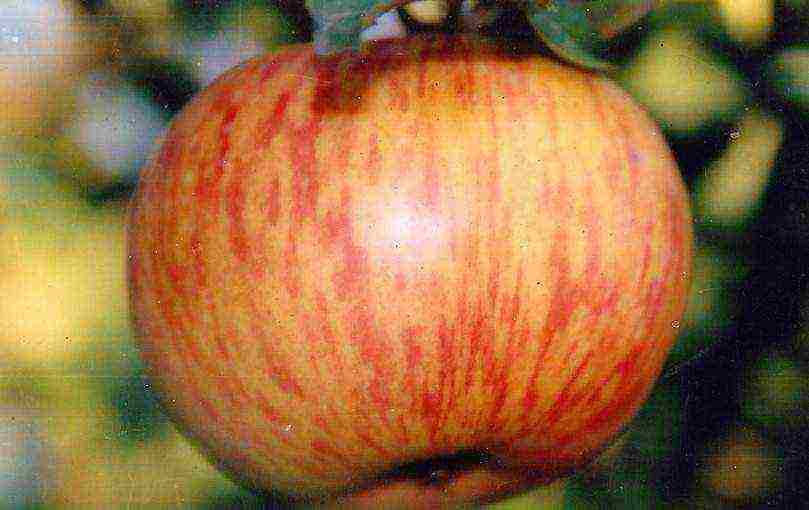
Autumn striped
Ural bulk
Despite the fact that this variety grows in almost every second yard, it is not very popular. With a mild taste, sweetness and good storage, the fruits are too small and always a lot of hassle with them. Moreover, the first harvest can be obtained already in the 2nd year of growth and every year.

Ural bulk
Beauty of Sverdlovsk
These apple trees are the best varieties for the Moscow region, and for the Urals, and even for Siberia. Calmly enduring long frosts, temperatures up to -30 with good insulation. Resistant to pests, in particular, bark beetles and other insects. The fruits themselves are small - 150-180 grams, but they are perfectly stored, with a mild sweet and sour taste, glossy barrels and a very expressive aroma. The main feature is that even overripe apples do not fall to the ground, which allows you to collect them all without loss and without rot.

Beauty of Sverdlovsk
Florina
Outwardly, very original fruits - with a slight lilac tint and a light whitish bloom. The average yield from one tree is up to 15 kg, with spring pollination it increases to 30 kg. Taste - sweet with a slight sour note, aromatic, very juicy, ideal for making juices. Stored for 6-7 months.
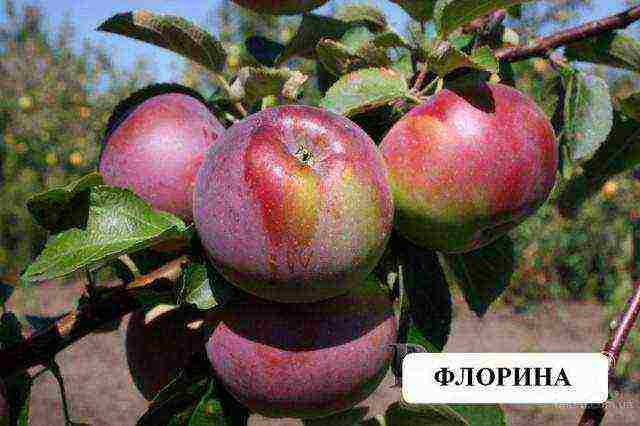
Florina
4 best apple varieties for central Russia
We repeat that it is necessary to choose seedlings first of all, taking into account climatic characteristics, soil fertility and taste preferences. Then the apple tree will really become a decoration and will bring a good harvest.
Early ripening red
S.P. Kedrin is the author of many selection finds, specialized and bred the best varieties of winter apple trees for the middle lane. So, for example, Skorospelka red is one of them. It tolerates cold well, is resistant to pests, reaches medium size and is decorated with a lush, rounded crown. The fruits are sweet, but with a sour aftertaste, with white flesh. They are not stored for long - up to 3 months.
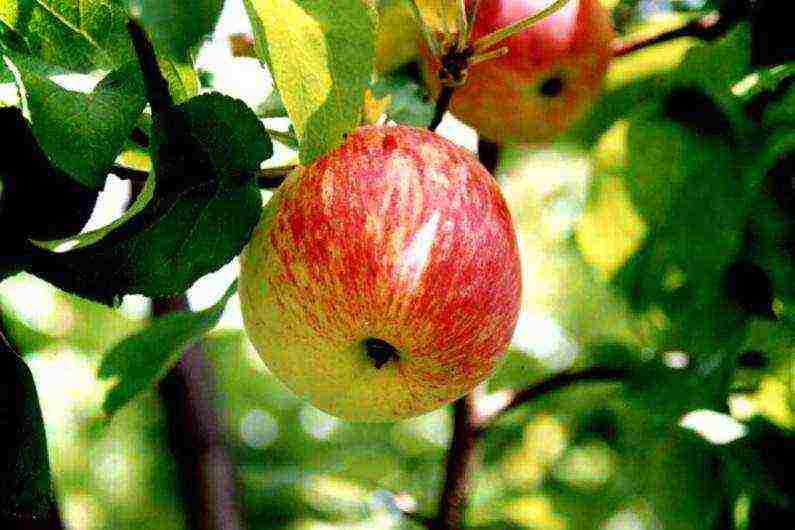
Early ripening red
Sweet anise (Terentyevka)
Pure Volga variety, originally bred specifically for this climate. The trees are squat with a high crown, the fruits are sweet with sour notes, small 40-50 grams, they are stored very little - literally up to 1 month. Juicy, due to which they are grown on an industrial scale for juices and other preservation.
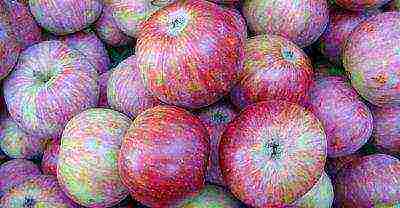
Anise sweet
Pearl
The result of the work of breeders, which has received popular recognition and love. The trees are squat, but very "fertile" - the harvest is annual, on average, up to 30 kg of fruit can be obtained from one tree. Pearl also leads in fruit size - these are the largest among other varieties, the size of which is not affected by the quality of the soil, nor the peculiarity of care, nor the fertility of the soil.

Pearl
Grushovka Moscow
It cannot be said that these are the best varieties of apple trees for the Moscow region, since the fruits are small, although very fragrant.But it is this variety that many prefer to see on their plots, since it bears fruit from late summer to late autumn, including the period of frost. Taste - sweet with a slight sourness, small fruits - up to 50 grams, stored for a long time. They crumble as they ripen, so it is best to remove them as they pour.

Grushovka Moscow
5 best varieties of apple trees for the Moscow region
In terms of climatic features, this territory is closer to the middle zone, while some areas have a milder climate. In particular, we are talking about the Kashirsky and Stupinsky regions, where apple trees are grown on an industrial scale.
Zhigulevskoe
Small trees that bring their first harvest as early as the 4th year of growth. It bears fruit every year and is abundant enough. Differs in resistance to frost and drought. It requires an abundance of nutrients, but at the same time, the root system is so powerful that it can receive the necessary elements from a plot of more than 50 m2. It is recommended to regularly add wood ash, rotted compost to the root zone, water it regularly and be sure to rid it of weeds. Over time, it gives a large number of side branches and shoots. Fruits are medium-sized, sweet, stored only until March, but with proper storage organization.
For reference! How to properly store apples in winter - first, they must be sorted and only those without dents, rot and wormholes should be left for storage. If the harvest is large, you can wipe each apple with a napkin with glycerin and put it in a box covered in sawdust by a third. If there are not many apples, it is advisable to wrap each one in a napkin or newspaper and put it in a box.

Zhigulevskoe
Delight
Hybrid semi-dwarf variety, characterized by a large thickening of the branches. It is imperative that annual pruning is carried out not so much for the formation of the crown, but for gaining access to the sun's inner branches. The tree is absolutely unpretentious, does not require any special conditions, but very gratefully takes any care of itself - increasing the yield. Fruits are original striped, sweet in taste. Stored for 4 months if properly organized (see above).
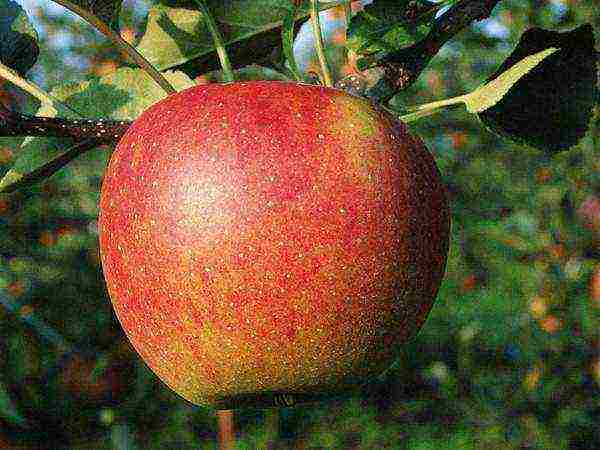
Delight
Wonderful
This is a product of the development of breeders from Chelyabinsk, which is distinguished by unpretentiousness to growing conditions and universal survival rate. Such a variety will take root equally well in the Urals and in the Crimea, and will also actively bear fruit. The original appearance - the small growth of the tree, the creeping crown add piquancy and fully justify the name Wonderful, but at the same time it gives a large yield of large fruits - up to 450 grams. The shelf life, although not long, but if everything is organized correctly, you can "hold out" until the new year. The fruits are sweet, juicy, used for preserving and making jam.
Although the variety is unpretentious, it reacts very sensitively to quality care - watering, feeding, removing weeds. The variety is resistant to external irritants, but since spring it is constantly attacked by aphids, which requires regular processing.
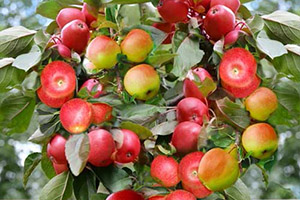
Wonderful
Read with this article: Which manure is better for fertilizing the soil
Lungwort
Ideal for those who are just trying their hand at growing apple trees. An unpretentious variety, resistant to long-term frost, does not require regular maintenance. It is noteworthy that the average duration of a tree is more than half a century and all this time it bears fruit. Over time, apples become smaller in size, but this is observed after 10-15 years of growth. Otherwise, the abundance of the harvest and the taste of the fruits will depend on the quality of care. Even the most unpretentious best varieties of Siberian apple trees for the Moscow region, the Urals, Siberia and other regions of Russia are very sensitive to the application of fertilizers and insulation.It is enough to add dry manure to the root zone at the end of autumn so that the tree receives the whole range of nutrients and minerals during the winter.

Lungwort
VIDEO: The best varieties of winter apple trees for the middle lane
